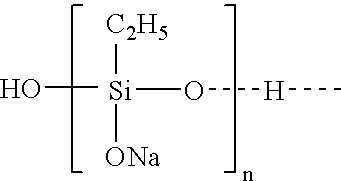Method of preventing or reducing aluminosilicate scale in a bayer process
a technology of aluminosilicate and aluminosilicate, which is applied in the direction of aluminium compounds, chemistry apparatus and processes, and the nature of treatment water, etc., can solve the problems of scale having low thermal conductivity, slow rate at which desilication products precipitate out, and high concentration of dissolved silica, so as to reduce or eliminate aluminosilicate scaling, reduce and even completely prevent the formation of aluminosilicate scal
- Summary
- Abstract
- Description
- Claims
- Application Information
AI Technical Summary
Benefits of technology
Problems solved by technology
Method used
Image
Examples
examples
[0040] Test procedure
[0041] A synthetic Bayer liquor is made by adding 12 ml of a sodium silicate solution (27.7 g / l of a sodium silicate solution that is 28.9% SiO2) to 108 ml of a sodium aluminate solution that contains sodium aluminate, excess sodium hydroxide, and sodium carbonate. After mixing, the solution contains 0.8 g / l SiO2, 45 g / l Al2O3, 150 g / l NaOH, and 40 g / l Na2CO3. If a scale reducing additive is used, it is added just before the silicate is added to the aluminate solution (generally the additive is used as a solution containing 1-10% of active reagent). This solution is put into a polyethylene bottle along with a strip of pre-weighed clean mild steel (25 mm x 95 mm) and the sealed bottle is heated with agitation at 100º for 18 + 2 hours. Eight to twelve such tests (bottles) are done at one time. At the end of the 18 hours, the bottles are opened, the steel strip is thoroughly rinsed and dried, and the solution is filtered (0.45( filter). Considerable aluminosi...
example 1
[0045] A polymer with the structure
[0046] is made as follows: 42 g of a styrene-maleic anhydride (SMA) copolymer, with a mole ratio of styrene to maleic anhydride of 2.0, is dissolved in 87 g of acetone. A separate solution is made with 3.03 g of gama-aminopropyltriethoxysilane, 8.02 g of diethylamine and 21 g of acetone. The amine solution is then added to the polymer solution and allowed to react for 15 minutes at ambient temperature. One hundred eighty milliliters (180 ml) of deionized (D.I.) water is mixed with 20 ml of 28% aqueous ammonia and heated to 70º. The aqueous ammonia is then added to the polymer solution and the mixture heated to 65º to evaporate the acetone. The result is a solution containing 23.4% polymer based on the total weight of SMA polymer and the two amines. It is tested in accordance with the Test Procedure described above with the following results reported in Table B.
TABLE BScale on steel,Total sodalite formed,Dosage, mg / l% vs. blank*% vs. blank*300005...
example 2
[0048] A 25.0 g aliquot of the polymer solution from Example 1 is added to 200 ml of isopropanol to precipitate the polymer, which is washed with isopropanol and dried. The dried polymer contains 0.80% silicon. A 2% solution of the isolated polymer is made in a mixture of NaOH and aqueous ammonia. It is tested in accordance with the Test Procedure with the results reported in Table C.
TABLE CScale on steel,Total sodalite formed,Dosage, mg / l% vs. blank*% vs. blank*300005000.21000.1
*no additive
[0049]
PUM
| Property | Measurement | Unit |
|---|---|---|
| Fraction | aaaaa | aaaaa |
| Fraction | aaaaa | aaaaa |
| Concentration | aaaaa | aaaaa |
Abstract
Description
Claims
Application Information
 Login to View More
Login to View More - R&D
- Intellectual Property
- Life Sciences
- Materials
- Tech Scout
- Unparalleled Data Quality
- Higher Quality Content
- 60% Fewer Hallucinations
Browse by: Latest US Patents, China's latest patents, Technical Efficacy Thesaurus, Application Domain, Technology Topic, Popular Technical Reports.
© 2025 PatSnap. All rights reserved.Legal|Privacy policy|Modern Slavery Act Transparency Statement|Sitemap|About US| Contact US: help@patsnap.com



